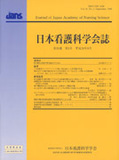Japanese
English
- 販売していません
- Abstract 文献概要
- 参考文献 Reference
要旨
本研究は,産褥期における腹直筋の筋力回復過程を明らかにすることを目的として,腹直筋の筋活動電位を測定し,対象者の属性および分娩時の状況との関連について分析した.初産婦29名(年齢29.0±2.9歳,身長158.7±4.7cm,体重49.9±4.2kg)を対象に,妊娠15週から25週の間で1回,産褥1日目から5日目の毎日,産褥2週,1カ月,2カ月および3カ月目に測定を行った.右上部腹直筋に貼付した電極により,アブドミナルカールの動作における筋活動電位を測定し,全波整流した後,台形公式を用いて200msecごとに連続的に積分して標準化した値を筋活動量とした.腹直筋の筋活動量回復には2カ月を要することが明らかとなり,褥婦の体形に対する不安を軽減する目安となると考えられる.また分娩時出血量と筋活動量の間に負の相関が認められ(r=-0.424),分娩時出血量に応じた保健指導を可能にすると考えられる.最後に,母乳哺育群は混合哺育群より,産褥1カ月目において筋活動量が有意に高いことが明らかとなり(p<0.05),母乳哺育の利点の一つとして保健指導に活用できると考えられる.
Abstract
This research evaluated a restoration process of muscular activity of rectus abdominis in the puerperal period by measuring surface electromyographic activity, and investigated the relation with the state of childbirth. Twenty nine primipara women (age:29.0±2.9 years, height: 158.7±4.7cm, body mass:49.9±4.2kg) participated in this study. The number of measurement for each woman was ten times. The first measurement period was between 15weeks and 25 weeks of gestation. Follow-on measurements were made every days during 5 days after delivery, and then at the 2nd week, 1st month, 2nd month and 3rd month. The surface electromyographic signals were recorded from the upper right portion rectus abdominis the subject was in an abdominal curl position. The recorded data were first rectified, and then calculated for 200ms continuously using the trapezium rule, and finally standardized with averaged value of each woman's data. The results of this study indicate that it takes two months to restore muscular activity in the rectus abdominal muscle from delivery. This result should help set the expectations and reduce the uneasiness associated with postpartum body image. A remarkable negative correlation was observed between the amount of intrapartum hemorrhage and muscular activity of the rectus abdominal muscle (r=-0.424). This result provides women during the postpartum period with health guidance according to amount of intrapartum hemorrhage. Moreover, the breastfeeding women had significantly more powerful abdominal muscles than the others at the 1st month postpartum(p<0.05), this result can be recommended as one of the advantages of breastfeeding.
Copyright © 2008, Japan Academy of Nursing Science. All rights reserved.


